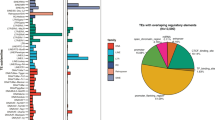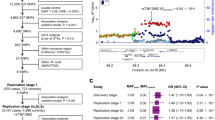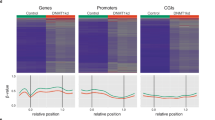Abstract
Histone modification is a crucial step in transcriptional regulation, and deregulation of the modification process is important in human carcinogenesis. We previously reported that upregulation of SMYD3, a histone methyltransferase, promoted cell growth in human colorectal and hepatocellular carcinomas. Here we report significant associations between homozygosity with respect to an allele with three tandem repeats of a CCGCC unit in the regulatory region of SMYD3 and increased risk of colorectal cancer (P = 9.1 × 10−6, odds ratio = 2.58), hepatocellular carcinoma (P = 2.3 × 10−8, odds ratio = 3.50) and breast cancer (P = 7.0 × 10−10, odds ratio = 4.48). This tandem-repeat sequence is a binding site for the transcriptional factor E2F-1. In a reporter assay, plasmids containing three repeats of the binding motif (corresponding to the high-risk allele) had higher activity than plasmids containing two repeats (the low-risk allele). These data suggest that the common variable number of tandem repeats polymorphism in SMYD3 is a susceptibility factor for some types of human cancer.
This is a preview of subscription content, access via your institution
Access options
Subscribe to this journal
Receive 12 print issues and online access
$209.00 per year
only $17.42 per issue
Buy this article
- Purchase on Springer Link
- Instant access to full article PDF
Prices may be subject to local taxes which are calculated during checkout



Similar content being viewed by others
Accession codes
References
Hamamoto, R. et al. SMYD3 encodes a histone methyltransferase involved in the proliferation of cancer cells. Nat. Cell Biol. 6, 731–740 (2004).
Boggs, B.A. et al. Differentially methylated forms of histone H3 show unique association patterns with inactive human X chromosomes. Nat. Genet. 30, 73–76 (2002).
Litt, M.D., Simpson, M., Gaszner, M., Allis, C.D. & Felsenfeld, G. Correlation between histone lysine methylation and developmental changes at the chicken beta-globin locus. Science 293, 2453–2455 (2001).
Schneider, R. et al. Histone H3 lysine 4 methylation patterns in higher eukaryotic genes. Nat. Cell Biol. 6, 73–77 (2004).
Bernstein, B.E. et al. Methylation of histone H3 Lys 4 in coding regions of active genes. Proc. Natl. Acad. Sci. USA 99, 8695–8700 (2002).
Bell, L.A. & Ryan, K.M. Life and death decisions by E2F–1. Cell Death Differ. 11, 137–142 (2004).
Black, A.R. & Azizkhan-Clifford, J. Regulation of E2F: a family of transcription factors involved in proliferation control. Gene 237, 281–302 (1999).
Stevaux, O. & Dyson, N.J. A revised picture of the E2F transcriptional network and RB function. Curr. Opin. Cell Biol. 14, 684–691 (2002).
Phillips, A.C. & Vousden, K.H. E2F–1 induced apoptosis. Apoptosis 6, 173–182 (2001).
Dyson, N. The regulation of E2F by pRB-family proteins. Genes Dev. 12, 2245–2262 (1998).
Harbour, J.W. & Dean, D.C. The Rb/E2F pathway: expanding roles and emerging paradigms. Genes Dev. 14, 2393–2409 (2000).
Spire-Vayron de la Moureyre, C. et al. Characterization of a variable number tandem repeat region in the thiopurine S-methyltransferase gene promoter. Pharmacogenetics 9, 189–198 (1999).
Nakamura, Y., Carlson, M., Krapcho, K., Kanamori, M. & White, R. New approach for isolation of VNTR markers. Am. J. Hum. Genet. 43, 854–859 (1988).
Nakamura, Y., Koyama, K. & Matsushima, M. VNTR (variable number of tandem repeat) sequences as transcriptional, translational, or functional regulators. J. Hum. Genet. 43, 149–152 (1998).
Nakamura, Y. et al. Variable number of tandem repeat (VNTR) markers for human gene mapping. Science 235, 1616–1622 (1987).
Zehbe, I., Voglino, G., Wilander, E., Genta, F. & Tommasino, M. Codon 72 polymorphism of p53 and its association with cervical cancer. Lancet 354, 218–219 (1999).
Bond, G.L. et al. A single nucleotide polymorphism in the MDM2 promoter attenuates the p53 tumor suppressor pathway and accelerates tumor formation in humans. Cell 119, 591–602 (2004).
Cai, Q. et al. Association of breast cancer risk with a GT dinucleotide repeat polymorphism upstream of the estrogen receptor-alpha gene. Cancer Res. 63, 5727–5730 (2003).
Krippl, P. et al. The 5A/6A polymorphism of the matrix metalloproteinase 3 gene promoter and breast cancer. Clin. Cancer Res. 10, 3518–3520 (2004).
De Vivo, I., Hankinson, S.E., Colditz, G.A. & Hunter, D.J. A functional polymorphism in the progesterone receptor gene is associated with an increase in breast cancer risk. Cancer Res. 63, 5236–5238 (2003).
Okabe, H. et al. Involvement of PEG10 in human hepatocellular carcinogenesis through interaction with SIAH1. Cancer Res. 63, 3043–3048 (2003).
Tang, C.J., Chuang, C.K., Hu, H.M. & Tang, T.K. The zinc finger domain of Tzfp binds to the tbs motif located at the upstream flanking region of the Aie1 (aurora-C) kinase gene. J. Biol. Chem. 276, 19631–19639 (2001).
Acknowledgements
We thank Y. Yamane for technical assistance and M. Kubo, K. Yamazaki, M. Kunizaki, K. Obama, M. Sakai, T. Kobayashi, K. Ura and S. Matsushima for discussions. This work was supported in part by a Research for the Future Program Grant from the Japan Society for the Promotion of Science.
Author information
Authors and Affiliations
Corresponding author
Ethics declarations
Competing interests
The authors declare no competing financial interests.
Supplementary information
Supplementary Table 1
Sequences of oligonucleotides. (PDF 21 kb)
Rights and permissions
About this article
Cite this article
Tsuge, M., Hamamoto, R., Silva, F. et al. A variable number of tandem repeats polymorphism in an E2F-1 binding element in the 5′ flanking region of SMYD3 is a risk factor for human cancers. Nat Genet 37, 1104–1107 (2005). https://doi.org/10.1038/ng1638
Received:
Accepted:
Published:
Issue Date:
DOI: https://doi.org/10.1038/ng1638
This article is cited by
-
Profiling human pathogenic repeat expansion regions by synergistic and multi-level impacts on molecular connections
Human Genetics (2023)
-
SMYD3: a regulator of epigenetic and signaling pathways in cancer
Clinical Epigenetics (2021)
-
Upregulation of SMYD3 and SMYD3 VNTR 3/3 polymorphism increase the risk of hepatocellular carcinoma
Scientific Reports (2020)
-
VHL-HIF-2α axis-induced SMYD3 upregulation drives renal cell carcinoma progression via direct trans-activation of EGFR
Oncogene (2020)
-
Residual expression of SMYD2 and SMYD3 is associated with the acquisition of complex karyotype in chronic lymphocytic leukemia
Tumor Biology (2016)



